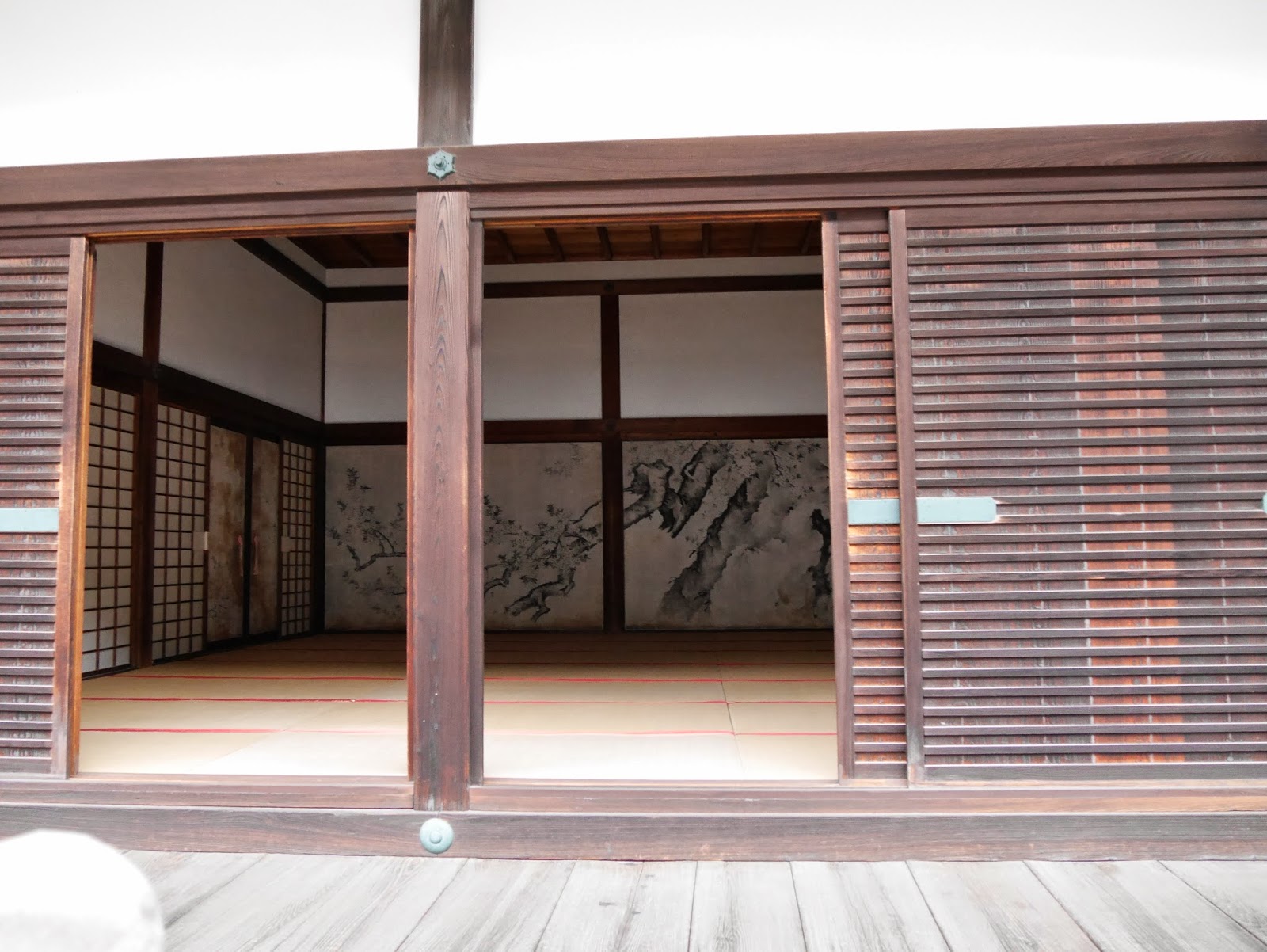Day 5: April 6 (Mon), Kyoto
We came to Kyoto, the capital of Japan before Meiji Era. Kyoto Gyoen was definitely a place must go.
We took subway to Marutamachi Station and came to the South Entrance of Kyoto Gyoen from Exit 1.
 |
| The South Entrance of Kyoto Gyoen |
 |
| Former Kan'in-no-miya Residential Palace, Kan'in-no-miya was one of the four main branches of Imperial Family of Japan. |
 |
| Road in Kyoto Gyoen |
 |
| Demizu-no-ogawa (出水の小川) |
Kyoto Gyoen is a big garden with flowers are everywhere, but sakura had withered away when we were there.
 |
| Peach flower |
A venerable tree, which held by four wooden piles, could be seen when walked to the corner of Kyoto Gosho (Former Imperial Palace). This big tree is known as Muku tree (Alangium tree) of the Shimizudani Residence after the house of a court noble Shimizudani who lived nearby. It is about 300 years old.
It is believed that Kijima Matabee, a Choshu samurai who led a radical "Revere the Emperor and expel the barbarians" ("Sonnojoi") group, was killed nearby during 1864 Kimmon Incident.
During that year, Choshu Han (Han means Domain, similar as prefecture in present-day), whose power was expelled from Kyoto previously, staged a coup d'état against Matsudaira Katamori, the Military Commissioner of Kyoto and the head of Aizu Han. They led an army attack the city and bombarded Kyoto Gosho and its surroundings with cannons. This caused a major destruction to Kyoto.
After the incident, Choshu Han was labelled as Choteki, or Emperor's enemy because of their bombardment on Imperial Palace. Choshu Han was then attacked by other Hans and this incident provokes a series of political struggles in the last few years of Shogunate.
 |
| The wall of Kyoto Gosho |
 |
| Gishu-mon, entrance when visiting Kyoto Gosho |
It's Special Open Days of Kyoto Gosho when we were there. Normally Kyoto Gosho hold their special open days during spring sand autumn. It's free to enter, the visitors' bags just need to be screened before visit.
Compared with Osaka, there was more Japanese than foreigners here. After entered Gishu-mon (mon means gate), left hand side was the office of Imperial Household Agency and Palace Police, while right hand side is Okurumayose. This was the entrance where dignitaries with special permission for official visits enter.
 |
| The roof of Okurumayose |
 |
| Okurumayose |
Okurumayose links with Shodaibunoma, dignitaries will wait here before enter the palace. They were ushered into three different anterooms according to their ranks. These rooms are named as, started from highest ranking, Tora-no-ma (Tiger Room), Tsuru-no-ma (Crane Room) and Sakura-no-ma (Sakura Room).
 |
| Sakura-no-ma |
 |
| Tsuru-no-ma |
 |
| Tora-no-ma |
The next building is Shinmikurumayose. It was built for Emperor Taisho's enthronement in 1915. It then becomes the genkan, or entrance for the Emperor and Empress. The building was designed in western style with flannelette blanket spread inside.
 |
| Shinmikurumayose |
Next to Shinmikurumayose is Gekka-mon (literally means Gate of Moon Glow). This gate is the western gate of Shishin-den. Three different styles of Ikebana (Japanese art of flower arrangement) were exhibited under the corridor beside Gekka-mon.
 |
| Gekka-mon, western gate of Shishin-den |
 |
| Ikebana beside Gekka-mon: Daigakuji Sagagoryu (大覚寺嵯峨御流) |
 |
| Ninnaji Omuroryu (仁和寺御室流) |
 |
| Sennyuji Getsurinmiseiryu (泉涌寺月輪未生流) |
After turning left, it is the most southern part of Gosho, where Kenrei-mon is located. Opposite of Kenrei-mon is the southern gate of Shishin-den, called Shomei-mon.
 |
| Kenrei-mon |
 |
| Shomei-mon |
 |
| View of Shishin-den from Shomei-mon |
 |
| The red gate at left hand side is Nikkamon, the eastern gate of Shishin-den. The building at right hand side is Shunko-den. |
Shunko-den was built during the enthronement of Emperor Taisho. It was used for enshrine the sacred mirror, which moved from Kensho of Imperial Palace in Tokyo. Sacred mirror (Yata-no-Kagami) is one of the Three Sacred Treasures of Japan, which another two are sword Kusanagi and the jewel Yasakani-no-Magatama. These Sacred Treasures are passed down through generations of Emperor of Japan. During the enthronement, the sacred mirror was installed in Shunko-den first, then the enthronement ceremony was started officially.
 |
| The model roof of Shishin-den, which made of bark of Japanese cypress. |
 |
| Shishin-den and Sakon-no-sakura (cherry at right) |
Shishin-den is the building where enthronement ceremony was held. It is the most important ceremonial building in Gosho. The imperial throne, Takamikura, is located at the center of Shishin-den, while its east side is the August Seat of the Empress, Michodai. Both thrones were constructed in 1913 for Emperor Taisho's enthronement ceremony.
In front of Shishin-den is Dantei (Southern Courtyard), which paved with white sand, while Sakon-no-sakura (cherry tree) and Ukon-no-tachibana (orange tree) were planted at both sides.
 |
| Ukon-no-tachibana |
 |
| Shomei-mon and Dantei located in front of Shishin-den |
 |
| Takamikura (Imperial throne, left) and Michodai (Empress's Throne, right) |
Behind Shishin-den is the palace and garden where Emperor conduct his own personal affairs and daily life. This will be introduced in next post.
Next:
Witness of Chrysanthemum Dynasty, Kyoto Gosho (2)































No comments:
Post a Comment